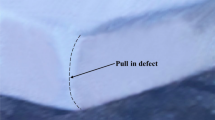Abstract
In this study, the analysis is carried out to optimize in-gate position and size of riser for casting mold. The baseline size of riser for the casting of boat propeller is based on geometric modulus and thermal analysis. The riser size is analyzed with thermal-volumetric numerical calculations to predict critical fraction solid (CFS) time and temperature gradient in casting. Simulation predictions are compared with inspection results of actual castings and found good qualitative agreement. The riser reached CFS temperature well before the castings’ cross-sectional transition regions. In feeding the molten metal, the in-gate is placed where the section modulus of casting is higher. However, the tongue of sand at in-gate increases the local cooling rate, resulting in early solidification and blockage of feeding path. The increase in riser size and in-gate position results in elimination of shrinkage cavities. An optical microscopy of the casting critical region is carried out to investigate the effect of numerical measures on internal closed microporosity and microstructure morphology.
Similar content being viewed by others
Abbreviations
- CFS :
-
Critical fraction solid
- M c :
-
Casting modulus
- V c :
-
Casting volume
References
A. M. Horr and J. Kronsteiner, Dynamic simulations of manufacturing processes: hybrid-evolving technique, Metals, 11(12) (2021) 1884.
F. Li, Y. Wang, D. Wang, Y. Zhao, C. Qi and B. Sun, Comparison of various gating systems for investment casting of hydraulic retarder impeller with complex geometry, Proceedings of the Institution of Mechanical Engineers, Part B: Journal of Engineering Manufacture, 235(4) (2021) 583–593.
G. Tian, Z. Ma, D. Zhao, H. Zhou, X. Jing, Z. Xie and G. Li, Research on the dynamic evolution of residual stress in thermal processing of diesel engine blocks based on FEM, Journal of Mechanical Science and Technology, 35(6) (2021) 2419–2430.
Y. Sun, J. Luo, G. F. Mi and X. Lin, Numerical simulation and defect elimination in the casting of truck rear axle using a nodular cast iron, Materials and Design, 32 (2011) 1623–1629.
A. K. Sheikh and M. A. A. Khan, Mold design optimization and quality assessment of steel castings through integrated simulations and experiments, Journal of Mechanical Science and Technology, 34(7) (2020) 2975–2983.
K. O. Yu, J. J. Nichols and M. Robinson, Finite-element thermal modeling of casting microstructures and defects, JOM, 44 (1992) 21–25.
R. Tavakoli, On the prediction of shrinkage defects by thermal criterion functions, The International Journal of Advanced Manufacturing Technology, 74 (2014) 569–579.
D. G. Eskin, L. Katgerman, Suyitno and J. F. Mooney, Contraction of aluminum alloys during and after solidification, Metallurgical and Materials Transactions A, 35 (2004) 1325–1335.
ASM International, Casting Design and Performance, Materials Park (2009).
S. Sutiyoko, Suyitno, M. Mahardika and A. Syamsudin, Prediction of shrinkage porosity in femoral stem of titanium investment casting, Archives of Foundry Engineering (2016) 157.
J. E. Spinelli, N. Cheung, P. R. Goulart, J. M. Quaresma and A. Garcia, Design of mechanical properties of Al-alloys chill castings based on the metal/mold interfacial heat transfer coefficient, International Journal of Thermal Sciences, 51 (2012) 145–154.
L. Gong, B. Chen, L. Zhang, Y. Ma and K. Liu, Effect of cooling rate on microstructure, microsegregation and mechanical properties of cast Ni-based superalloy K417G, Journal of Materials Science and Technology, 34 (2018) 811–820.
E. Pan, C. Lin and C. Loper, Effects of solidification parameters on the feeding efficiency of A356 aluminum alloy, AFS Transactions, 98 (1990) 135–146.
I. Sowden and G. Currier, Improving casting integrity through the use of simulation software and advanced inspection methods, 2012 Joint Rail Conference, Philadelphia (2012) 255–261.
K. D. Carlson and C. Beckermann, Prediction of shrinkage pore volume fraction using a dimensionless niyama criterion, Metallurgical and Materials Transactions A, 40 (2009) 163–175.
B. G. Thomas, Ch. 14 — Metal Processing, Structure, Processing, and Properties of Engineering Materials, J. Adams (Ed.), Addison Wesley, Boston (2000).
ASM International, Worldwide Guide to Equivalent Nonferrous Metals and Alloys, 4th Edition, Materials Park (2009).
S. A. Salihu, A. Usman and I. Y. Suleiman, Effect of variation of different additives on some selected properties of silica sand mould for aluminium castings, Journal of Engineering and Technology Research, 12(1) (2020) 24–36.
T. Haga, S. Imamura and H. Fuse, Fluidity investigation of pure Al and Al−Si alloys, Materials, 14(18) (2021) 5372.
D. M. Stefanescu, Computer simulation of micro- and macro-shrinkage and of metal penetration defects in metal casting, 3rd International Conference on Computational Modeling and Simulation of Materials, Acireale (2004).
H. Iqbal, A. K. Sheikh, A. Al-Yousef and M. Younas, Mold design optimization for sand casting of complex geometries using advance simulation tools, Materials and Manufacturing Processes, 27 (2012) 775–785.
Z. D. Kadhim, Effect of cooling rate on mechanical properties of eutectic and hypoeutectic Al−Si alloys, Journal of Engineering, 17 (2011) 1576–1583.
ASTM E155, Standard Reference Radiographs for Inspection of Aluminum and Magnesium Castings, West Conshohocken (1979).
Acknowledgments
This work was supported by the research grant of Jeju National University in 2021.
Author information
Authors and Affiliations
Corresponding authors
Additional information
Woo Young Kim received his B.S. in Electronic Engineering from Kyungpook National University and Ph.D. in Electrical Engineering from KAIST. He is currently working as an Associate Professor at the Jeju National University. His research interest is focused on the development of novel energetic materials for smart electromechanical devices and simulation studies of materials.
Muhammad Zafar received his B.Sc. in Chemical Engineering from NFC-IET, M.Sc. from University of the Punjab and Ph.D. from Chonnam National University. He is currently working as an Assistant Professor at the University of the Punjab. His research interest is focused on the synthesis of materials for various engineeering applications.
Rights and permissions
About this article
Cite this article
Ali, R., Zafar, M., Manzoor, T. et al. Elimination of solidification shrinkage defects in the casting of aluminum alloy. J Mech Sci Technol 36, 2345–2353 (2022). https://doi.org/10.1007/s12206-022-0416-z
Received:
Revised:
Accepted:
Published:
Issue Date:
DOI: https://doi.org/10.1007/s12206-022-0416-z




